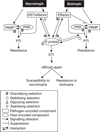Plants versus pathogens: an evolutionary arms race
- PMID: 21743794
- PMCID: PMC3131095
- DOI: 10.1071/FP09304
Plants versus pathogens: an evolutionary arms race
Abstract
The analysis of plant-pathogen interactions is a rapidly moving research field and one that is very important for productive agricultural systems. The focus of this review is on the evolution of plant defence responses and the coevolution of their pathogens, primarily from a molecular-genetic perspective. It explores the evolution of the major types of plant defence responses including pathogen associated molecular patterns and effector triggered immunity as well as the forces driving pathogen evolution, such as the mechanisms by which pathogen lineages and species evolve. Advances in our understanding of plant defence signalling, stomatal regulation, R gene-effector interactions and host specific toxins are used to highlight recent insights into the coevolutionary arms race between pathogens and plants. Finally, the review considers the intriguing question of how plants have evolved the ability to distinguish friends such as rhizobia and mycorrhiza from their many foes.
Figures



Similar articles
-
Seeing is believing: Exploiting advances in structural biology to understand and engineer plant immunity.Curr Opin Plant Biol. 2022 Jun;67:102210. doi: 10.1016/j.pbi.2022.102210. Epub 2022 Apr 20. Curr Opin Plant Biol. 2022. PMID: 35461025 Review.
-
Exploring folds, evolution and host interactions: understanding effector structure/function in disease and immunity.New Phytol. 2020 Jul;227(2):326-333. doi: 10.1111/nph.16563. Epub 2020 Apr 23. New Phytol. 2020. PMID: 32239533 Review.
-
Natural variation in priming of basal resistance: from evolutionary origin to agricultural exploitation.Mol Plant Pathol. 2010 Nov;11(6):817-27. doi: 10.1111/j.1364-3703.2010.00645.x. Mol Plant Pathol. 2010. PMID: 21029325 Free PMC article. Review.
-
Origin and evolution of the plant immune system.New Phytol. 2019 Apr;222(1):70-83. doi: 10.1111/nph.15596. Epub 2019 Jan 7. New Phytol. 2019. PMID: 30575972 Review.
-
The battle in the apoplast: further insights into the roles of proteases and their inhibitors in plant-pathogen interactions.Front Plant Sci. 2015 Aug 3;6:584. doi: 10.3389/fpls.2015.00584. eCollection 2015. Front Plant Sci. 2015. PMID: 26284100 Free PMC article. Review.
Cited by
-
Transcriptome analysis of a rice cultivar reveals the differentially expressed genes in response to wild and mutant strains of Xanthomonas oryzae pv. oryzae.Sci Rep. 2019 Mar 6;9(1):3757. doi: 10.1038/s41598-019-39928-2. Sci Rep. 2019. PMID: 30842619 Free PMC article.
-
Plant-microbe interactions through a lens: tales from the mycorrhizosphere.Ann Bot. 2024 Apr 10;133(3):399-412. doi: 10.1093/aob/mcad191. Ann Bot. 2024. PMID: 38085925 Free PMC article. Review.
-
Assessing Biofungicides and Host Resistance against Rhizoctonia Large Patch in Zoysiagrass.Pathogens. 2024 Oct 2;13(10):864. doi: 10.3390/pathogens13100864. Pathogens. 2024. PMID: 39452735 Free PMC article.
-
Progress and prospectus in genetics and genomics of Phytophthora root and stem rot resistance in soybean (Glycine max L.).Front Genet. 2022 Nov 14;13:939182. doi: 10.3389/fgene.2022.939182. eCollection 2022. Front Genet. 2022. PMID: 36452161 Free PMC article. Review.
-
What determines host specificity in hyperspecialized plant parasitic nematodes?BMC Genomics. 2019 Jun 6;20(1):457. doi: 10.1186/s12864-019-5853-4. BMC Genomics. 2019. PMID: 31170914 Free PMC article.
References
-
- Altenbach D, Robatzek S. Pattern recognition receptors: from the cell surface to intracellular dynamics. Molecular Plant–Microbe Interactions. 2007;20:1031–1039. doi:10.1094/MPMI-20-9-1031. - PubMed
-
- Araki H, Tian D, Goss EM, Jakob K, Halldorsdottir SS, Kreitman M, Bergelson J. Presence/absence polymorphism for alternative pathogenicity islands in Pseudomonas viridiflava, a pathogen of Arabidopsis; Proceedings of the National Academy of Sciences of the United States of America; 2006. pp. 5887–5892. doi:10.1073/pnas.0601431103. - PMC - PubMed
-
- Asai T, Tena G, Plotnikova J, Willmann MR, Chiu WL, Gomez-Gomez L, Boller T, Ausubel FM, Sheen J. MAP kinase signalling cascade in Arabidopsis innate immunity. Nature. 2002;415:977–983. doi:10.1038/415977a. - PubMed
-
- Axtell MJ, Staskawicz BJ. Initiation of RPS2-specified disease resistance in Arabidopsis is coupled to the AvrRpt2-directed elimination of RIN4. Cell. 2003;112:369–377. doi:10.1016/S0092-8674(03)00036-9. - PubMed
-
- Bari R, Jones J. Role of plant hormones in plant defence responses. Plant Molecular Biology. 2009;69:473–488. doi:10.1007/s11103-008-9435-0. - PubMed
Grants and funding
LinkOut - more resources
Full Text Sources
